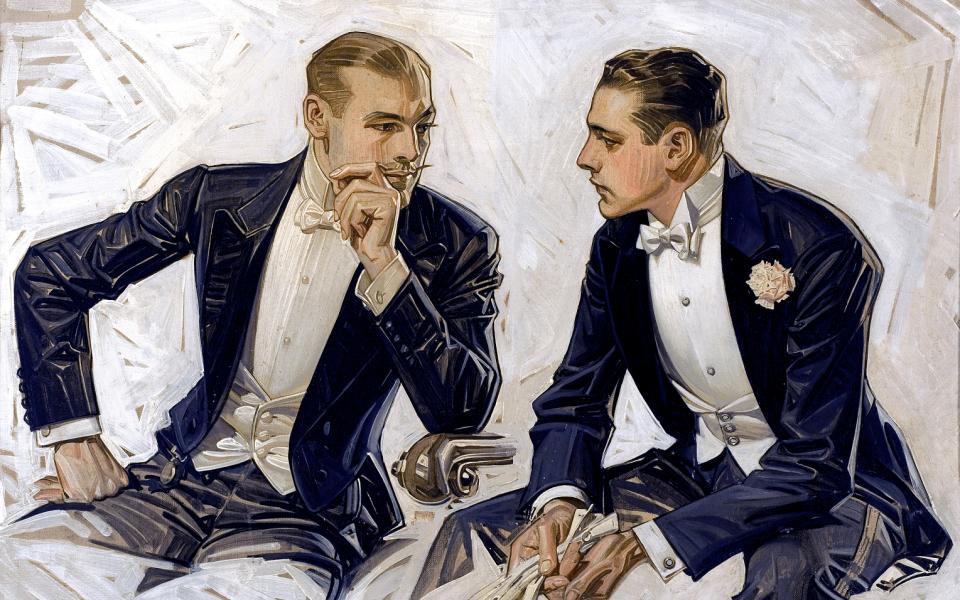A
small baby holds onto a parachute, a burst of confetti surrounding him as he
welcomes the New Year. A floral arrangement becomes a gift to a matriarch
celebrating the first Mother’s Day in 1914. A linebacker rests with a football
in his hands on a late November day. A bearded, rosy-cheeked man in a red suit
with white fur trim hugs a small child, a sack of gifts precariously balancing
on his shoulder.
Each
of these iconic images had once been ideas, painted out in brushstrokes by
Joseph Christian Leyendecker, a prolific illustrator with a career spanning
almost half of the early 20th Century. Now, more than 100 works by Leyendecker
hang at the Reynolda House Museum in Winston-Salem.
Leyendecker
lived from 1874 to 1951, working as an illustrator and marketing advertiser.
For decades, his works would be found on the cover of the Saturday Evening Post, influencing the likes of Norman Rockwell.
With visible brushstrokes and a slight stylization to his pieces, the artist
developed several icons of American culture: the Thanksgiving football game,
Mother’s Day flowers and an early version of Santa Claus.
“Leyendecker is interesting because the work is familiar,” Phillip Archer, deputy director of the Reynolda House, said. “He’s sort of the most famous artist we didn’t know we knew.”
Archer
finds that Leyendecker’s work fits into the same realm that the Reynolds lived
within. According to him, the same issues of the Saturday Evening Post could very well have been found strewn about
the Reynolda House in the era of its preservation — the works seem to give even
more of a glimpse into the trends that families like that of RJ and Katherine
Reynolds would have indulged in.
“Joseph
Leyendecker especially was enormously influential in helping to build a shared
sense of culture,” Archer said, “because his illustrations were omnipresent in
advertisements and magazine covers. His work just completely overlaps with the
era that Reynolda interprets.”
The
exhibit feels like a walk through decades of consumerism. The beginning
features oil paintings, studies of people and charcoal etches that capture quickly
fading moments. As it goes on, advertising displays show up more. The larger
pieces become magazine covers. A row of collars hangs on the wall.
-

J.C. Leyendecker, New Year’s Baby 1930, 1929, oil on canvas, (c) 2019 National Museum of
American Illustration, Newport, RI. Photo courtesy American Illustrators Gallery, New York, NY -

J.C. Leyendecker, Chase, 1923, oil on canvas, (c) 2019 National Museum of American
Illustration, Newport, RI. Photo courtesy American Illustrators Gallery, New York, NY
One
figure keeps popping up: the Arrow Collar man. Based on his life partner,
Charles Beach, the Arrow Collar man symbolized a brand of shirts. With a clean
stroke of white paint around the neck, a bust of Beach alone enticed customers
into buying an Arrow Shirt of their own.
If you look past the pleasing color palettes and the expert oil painting, though, you can see something else.
As much as Leyendecker’s works shaped American culture, his pieces become a mirror for it, including its ugly side.
Though
Beach served as the main model for the Arrow Collar Man, references to him seem
shrouded in subtlety, for the self-preservation and safety due to the taboo of
homosexuality in society. An educational blurb of text mentions how the Arrow
Collar man became a sex symbol, standing for refined tastes, yet looking at the
works, both the model and the painter’s sexuality remain hidden.
A
quote from Norman Rockwell in the exhibit states that Leyendecker could “never
paint a woman with any sympathy.” Without much interest in the complexities of
women’s lives, it makes sense that only one of his many icons, the Mother’s Day
flowers, relates to female experiences.
In
other works, people of color are only portrayed as servants to an idealized and
romanticized white middle class. Depictions of black men are limited to those
of servitude, which is pointed out beside a large original piece of a man
offering up a silver platter full of pork for a Christmas feast. Black women
are relegated to roles as caregivers and nannies for white children. The works
of advertisements and marketing seem to reflect the time, drawing on pre-Civil
Rights era attitudes.

Museum of American Illustration, Newport, RI. Photo courtesy American Illustrators Gallery,
New York, NY.
An
original painting of a 1937 Saturday
Evening Post cover shows a pair of children hanging onto a street pole. A
blond boy waves his cap in the air, excitedly gazing at the festivities.
Gripping tightly onto the pole below him sits a young black boy, his glance
cast downward, timid and seeming unsure of his stability. A note beside it
mentions that the model in question was asked by Leyendecker to pose looking
afraid.
The piece is captioned “July Fourth.”
Leyendecker and the Golden Age of American Illustration runs through Dec. 31st. Learn more at reynoldahouse.org.
Join the First Amendment Society, a membership that goes directly to funding TCB‘s newsroom.
We believe that reporting can save the world.
The TCB First Amendment Society recognizes the vital role of a free, unfettered press with a bundling of local experiences designed to build community, and unique engagements with our newsroom that will help you understand, and shape, local journalism’s critical role in uplifting the people in our cities.
All revenue goes directly into the newsroom as reporters’ salaries and freelance commissions.


Leave a Reply